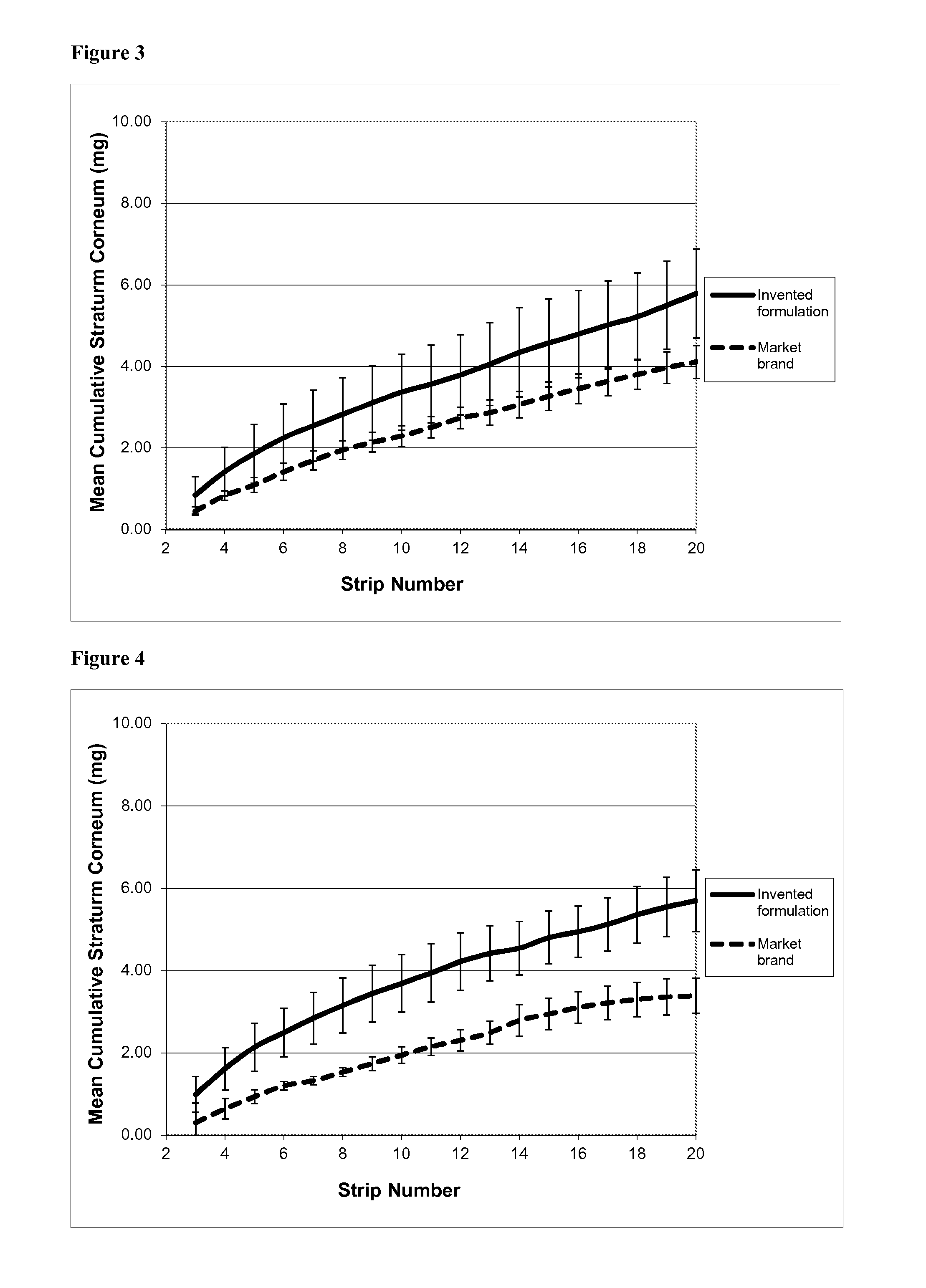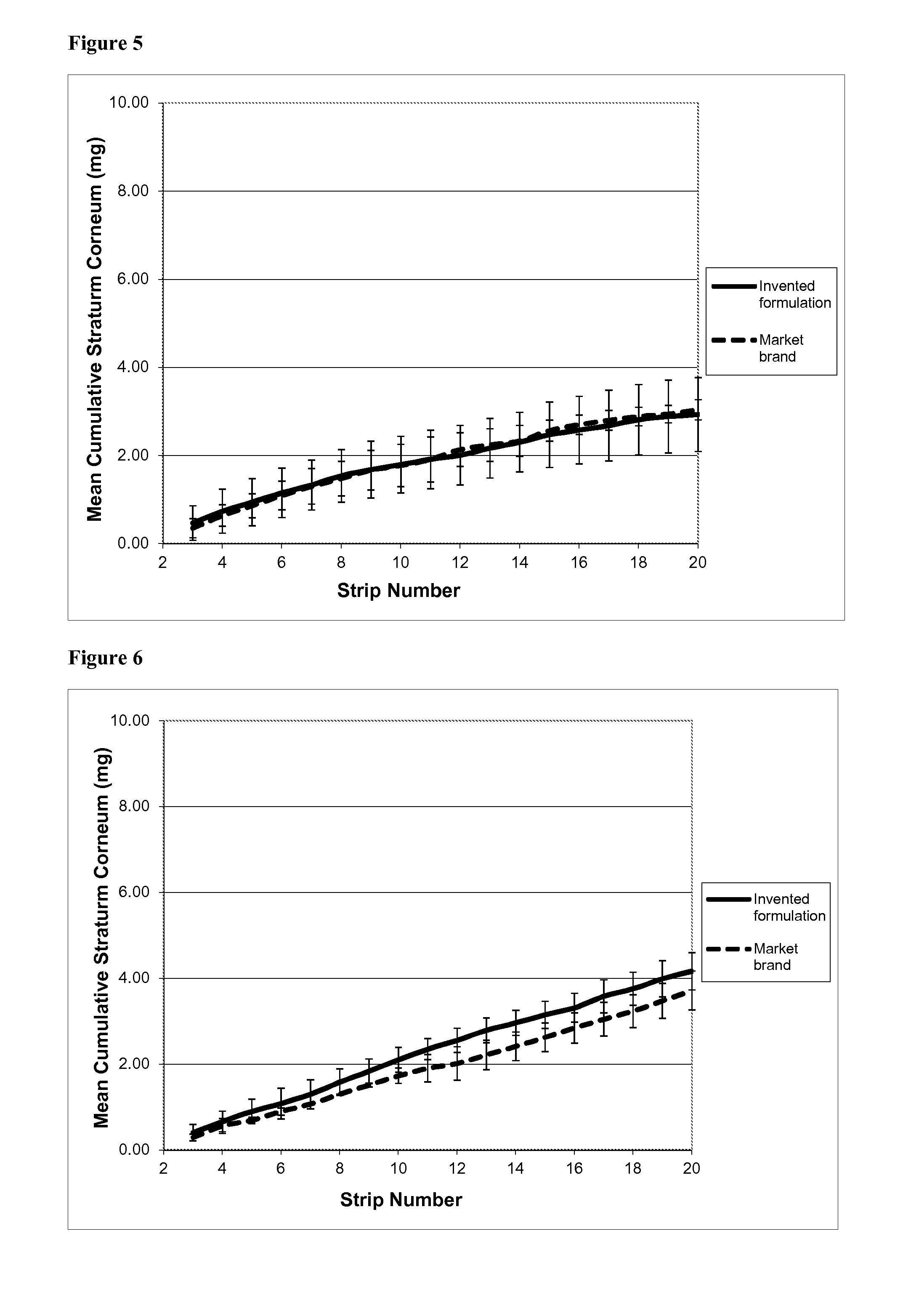Salicylic acid topical formulation
a topical formulation and salicylic acid technology, applied in the field of topical skin treatment formulations, can solve the problems of limiting the duration, and often the magnitude, of the therapeutic effect, and it is undesirable to try to increase the effectiveness of a topical, so as to improve the persistence of salicylic acid, increase the speed of keratolytic action, and improve the effect of salicylic acid penetration
- Summary
- Abstract
- Description
- Claims
- Application Information
AI Technical Summary
Benefits of technology
Problems solved by technology
Method used
Image
Examples
example 1
Formulation A
[0119]A gel formulation A according to the invention was prepared using the components and concentrations listed in Table 1. Copper usnate was present as an antibacterial agent, known to be active against the propionibacteria which are implicated in inflammatory acne. The first seven components together represented the solvent system in which the salicylic acid and copper usnate actives were dissolved.
TABLE 1Formulation AConcentrationComponent(% w / w)SourceDimethyl isosorbide (DMI)30Sigma-Aldrich, UKEthyl pyrrolidone20Sigma-Aldrich, UKEthyl pyruvate13.5Sigma-Aldrich, UKHomosalate10TCI EuropePEG-8 caprylic / capric10GatefosseglyceridesMethyl glucose dioleate5Surfachem Group LtdPCA glyceryl oleate5Dr Straetmans ChemischeProdukte GmbHSalicylic acid2Sigma-Aldrich, UKCopper usnate1VariatiAntioxidant (ascorbyl1Sigma-Aldrich, UKpalmitate)Thickener (hydroxypropyl2Honeywill & Stein Ltdcellulose)Oleic acid0.5Sigma-Aldrich, UKTOTAL100.0PCA = L-pyrrolidone carboxylic acid
[0120]The for...
example 2
Formulation Delivery in Vivo (Formulation A)
[0121]This experiment used formulation A as described in Example 1, containing salicylic acid as a keratolytic and anti-acne active substance. It investigated the rate and depth of penetration of the salicylic acid into the stratum corneum; the speed of onset of its keratolytic action; and its persistence in the skin following application. The method used was the so-called “tape stripping” method.
[0122]Tape Stripping—Background
[0123]As discussed above, salicylic acid (SA) is a well established topical treatment for mild to moderate acne, and there are several clinical study reports to support its efficacy (see Roth H L, “Acne vulgaris: evaluation of a medicated cleansing pad”, Calif Med 1964, 100(165): 167; Shalita A R, “Treatment of mild and moderate acne vulgaris with salicylic acid in an alcohol-detergent vehicle”, Cutis 1981, 28(5): 556-558; and Eady E A et al, “The benefit of 2% salicylic acid lotion in acne—A placebo-controlled study...
example 3
Formulations B to E
[0150]Further skin treatment formulations B to E were prepared using the components and concentrations listed in Table 2. Concentrations are quoted as percentages by weight (% w / w). Formulations B and C, which contained no thickener, had the form of solutions rather than gels.
TABLE 2IngredientBCDECopper usnate1111DMI30303029.95Homosalate1010109.98Glyceryl diisostearate2038PCA glyceryl oleate54.99THFA20Ethanol19PEG-8 caprylic / capric glycerides181010Ethyl pyrrolidone2019.97Methyl glucose dioleate54.99Ethyl pyruvate14.514.55Oleic acid0.50.57PCA1Antioxidant11Thickener22Salicylic acid1111Total100100100100
[0151]The THFA and ethanol were sourced from Sigma-Aldrich, UK, and the glyceryl diisostearate from Dr Straetmans Chemische Produkte GmbH.
[0152]The formulations were prepared using an analogous method to that of Example 1. The copper usnate was premixed with the DMI, the homosalate and where appropriate the ethyl pyrrolidone, THFA and ethyl pyruvate. The mixture was he...
PUM
| Property | Measurement | Unit |
|---|---|---|
| temperature | aaaaa | aaaaa |
| temperature | aaaaa | aaaaa |
| pressure | aaaaa | aaaaa |
Abstract
Description
Claims
Application Information
 Login to View More
Login to View More - R&D
- Intellectual Property
- Life Sciences
- Materials
- Tech Scout
- Unparalleled Data Quality
- Higher Quality Content
- 60% Fewer Hallucinations
Browse by: Latest US Patents, China's latest patents, Technical Efficacy Thesaurus, Application Domain, Technology Topic, Popular Technical Reports.
© 2025 PatSnap. All rights reserved.Legal|Privacy policy|Modern Slavery Act Transparency Statement|Sitemap|About US| Contact US: help@patsnap.com



